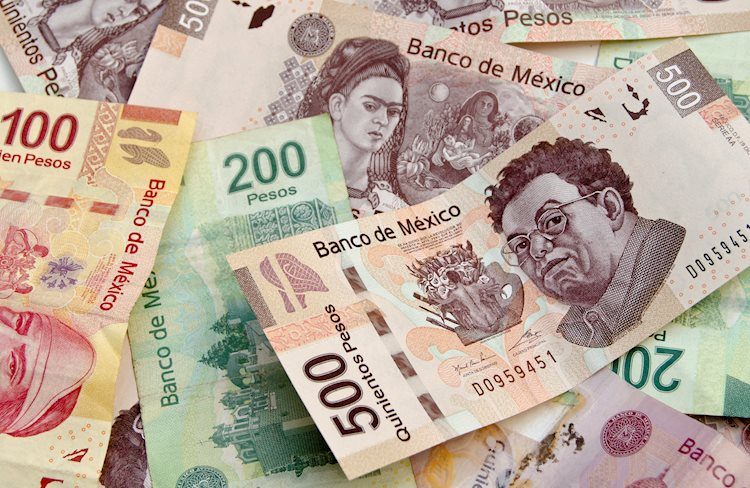- Mexican Peso extends its rally, capitalizing on a weaker USD.
- Mexico’s GDP growth aligns with expectations and might refrain Banxico’s officials from easing monetary policy.
- Mixed US economic data, with improving business activity but a downturn in Manufacturing PMI, weighed on the USD/MXN pair.
Mexican Peso (MXN) is set to finish the week on a higher note against the US Dollar (USD) after solid data from Mexico suggests the USD/MXN would finish November with more than 5% losses. At the time of writing, the exotic pair exchanges hands at 17.10, and falls 0.43% on Friday.
Today’s session was characterized by the release of solid economic data from Mexico, as the economy grew above estimates quarterly and over a 12-month period, reported the National Statistics Agency (INEGI) . That data, along with Thursday’s inflation report, gave mixed signals to Bank of Mexico (Banxico) officials, which opened the door to easing monetary policy during the first quarter of 2024.
On the US front, business activity showed signs that it remains improving, according to the S&P Composite and Services PMI. The outlier was Manufacturing, which dropped into recessionary territory.
Daily digest movers: Mexican Peso helped by solid economic growth and a steady disinflation process
- Mexico’s GDP growth for Q3 came at 3.3% YoY, as foreseen, exceeding the previous reading. Quarterly basis rose by 1.1%, peaking forecasts and the previous figures of 0.9% and 0.8%, respectively.
- The Mexican Consumer Price Index (CPI) for mid-November annually increased by 4.32%, exceeding estimates of 4.31%.
- US S&P Global Services and Composite PMIs came at 50.8, exceeding estimates, and at 50.7, above forecasts, unchanged from the previous report.
- Manufacturing activity revealed by US S&P Global, witnessed the index dropping from 50 to 49.4, below estimates of 49.8.
- Core CPI in Mexico decelerated compared to previous data and slowed to 5.31%, below forecasts of 5.33%.
- A Citibanamex poll suggests that 25 of 32 economists polled expect Banxico’s first rate cut in the first half of 2024.
- The poll shows “a great dispersion” for interest rates next year, between 8.0% and 10.25%, revealed Citibanamex.
- The same survey revealed that economists foresee headline annual inflation at 4% and core at 4.06%, both readings for the next year, while the USD/MXN exchange rate is seen at 19.00, up from 18.95, toward the end of 2024
- Data published last week showed prices paid by consumers and producers in the US dipped, increasing investors’ speculations that the Fed’s tightening cycle has ended.
- The swap market suggests traders expect 84 basis points of rate cuts by the Fed in 2024.
Technical Analysis: Mexican Peso in the driver’s seat, as USD/MXN threatens to close the week below 17.10
The USD/MXN pair was undermined by upbeat economic data, which pushed the pair below the 17.10 mark, reaching a three-day low of 17.08. The bias remains downward, and the pair could extend its losses if it breaches the November 21 swing low of 17.06. If that level is surrendered, a test of 17.00 is on the cards.
On the other hand, if buyers reclaim 17.20, that could facilitate a jump to the 100-day Simple Moving Average (SMA) at 17.34. Once buyers regain that supply zone, further upside could be witnessed at the 20-day SMA at 17.46.
Inflation FAQs
Inflation measures the rise in the price of a representative basket of goods and services. Headline inflation is usually expressed as a percentage change on a month-on-month (MoM) and year-on-year (YoY) basis. Core inflation excludes more volatile elements such as food and fuel which can fluctuate because of geopolitical and seasonal factors. Core inflation is the figure economists focus on and is the level targeted by central banks, which are mandated to keep inflation at a manageable level, usually around 2%.
The Consumer Price Index (CPI) measures the change in prices of a basket of goods and services over a period of time. It is usually expressed as a percentage change on a month-on-month (MoM) and year-on-year (YoY) basis. Core CPI is the figure targeted by central banks as it excludes volatile food and fuel inputs. When Core CPI rises above 2% it usually results in higher interest rates and vice versa when it falls below 2%. Since higher interest rates are positive for a currency, higher inflation usually results in a stronger currency. The opposite is true when inflation falls.
Although it may seem counter-intuitive, high inflation in a country pushes up the value of its currency and vice versa for lower inflation. This is because the central bank will normally raise interest rates to combat the higher inflation, which attract more global capital inflows from investors looking for a lucrative place to park their money.
Formerly, Gold was the asset investors turned to in times of high inflation because it preserved its value, and whilst investors will often still buy Gold for its safe-haven properties in times of extreme market turmoil, this is not the case most of the time. This is because when inflation is high, central banks will put up interest rates to combat it.
Higher interest rates are negative for Gold because they increase the opportunity-cost of holding Gold vis-a-vis an interest-bearing asset or placing the money in a cash deposit account. On the flipside, lower inflation tends to be positive for Gold as it brings interest rates down, making the bright metal a more viable investment alternative.
